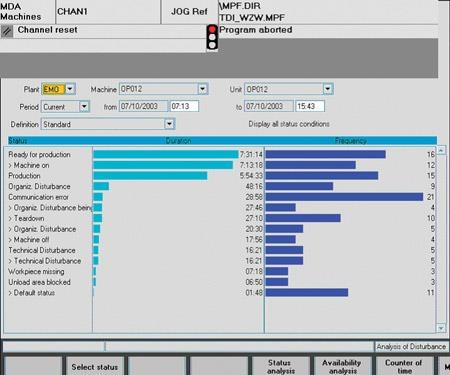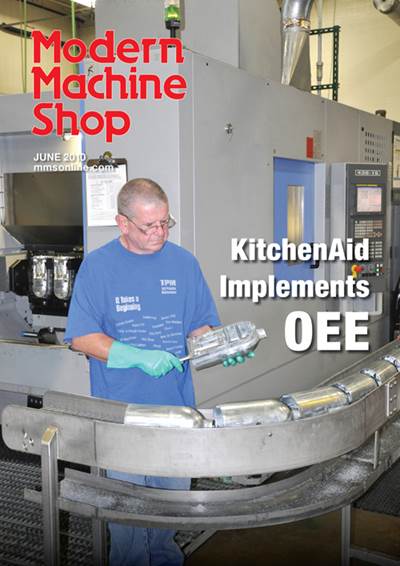Determine Equipment Effectiveness
Keeping the "green" lights on is the goal of overall equipment effectiveness (OEE).
Overall equipment effectiveness is a measurement methodology that helps track, identify and improve machine use in manufacturing. While it has traditionally been applied in large manufacturing plants, the concepts can also be used in small to medium shops.
With a basic understanding of OEE, a shop can determine where and why downtime is occurring on the shop floor, so corrective actions can be made leading to increased profits through better equipment utilization. Getting started is as simple as gathering data through automatic status and variable monitoring, features that reside on most of today’s CNC machine tools.
Why Track OEE?
Everyone has the ever-present requirement to be more profitable and reduce unnecessary losses. When Factory A needs to make the same part more cost effectively than Factory B, as they both seek to compete on the same job, understanding OEE can give Factory A the insight needed to outperform Factory B, time after time.
In some ways, there is a “hidden factory” within a factory. In order to improve performance on the shop floor, this hidden factory needs to be discovered and measured. OEE is such a discovery and measurement tool that can help a shop identify machine capacity, utilization rates and can help identify where quality or process improvements can be made. It also gives insight into the hidden costs of machine-related production losses such as unplanned downtime. By charting downtime through an OEE system, patterns will emerge, and the leading causes for unplanned downtime can be identified and corrected.
The measurements derived from OEE can also be used to improve processes. Throughput can be optimized by identifying various machine-related bottlenecks that are causing productivity losses. Identification and correction of these bottlenecks lead to reduction in the variability of the manufacturing process, providing the opportunity for process optimization.
Some shops have also experienced an increase in workforce cooperation when OEE is implemented. In these cases, the visibility from understanding the performance of a machine or department against a defined goal tends to lead to better productivity and shopfloor performance. Identified causes for performance degradation available though an OEE system can improve interdepartmental cooperation among maintenance, production and engineering, as the clear causes leave little opening for assumptions to be made. This allows all departments to focus on fixing the cause, not why the cause occurred.
Whether the shop is producing 1,000 parts an hour or one part with a cycle time of 2 weeks, shops can benefit from the knowledge gained by increasing transparency into CNC system operation. An OEE system can be implemented in a phased and scalable way. Initially, a focus on determining a percentage of machine utilization can be made, which compares actual production time with planned production time. From this simple measurement, improvements can be identified and implemented.
When users ask for an OEE system, it’s typically followed by a statement indicating that they are also interested in tracking the motor current, feed rates and tool data, along with understanding when and who changed a part program on every machine in their shop. While capturing this data can certainly be referred to as good information that can help paint a picture of what is going on in the facility, the process does not fall under the true definition of OEE.
OEE 101: Getting Started
The first and foremost part of understanding OEE is the realization that the data captured from the CNC on each machine on the shop floor is broken down into time and counters. Think of it as buckets of time. Each of these buckets is called a “state.” These states are to better understand what happened to the time during the day while counters are simultaneously used to determine if the time was used productively to produce a quality part.
Use a typical person’s day as a simple example: In Bucket A (state = sleeping) is the amount of time spent sleeping; in Bucket B (state = commuting) is the amount of time it took to commute to and from work; in Bucket C (state = production) is the amount of time spent at work; and in Counter 1 (good, bad, rework) is the outcome of the day (good day, bad day and so on).
An OEE system gathers the buckets of time and counter values and reports them back to the end user, displaying how much time falls in each bucket or how many counters are in each bucket. Ultimately, the system generates a calculated OEE number, which can be used to measure improvement over time. In many manufacturing environments, an OEE number of 85 percent or above is considered world class.
Management, either at a huge production department or ten-person shop, likes the OEE number, as it appears in a dashboard and is something they can use as a benchmark or key performance indicator. They can easily use the OEE numbers to gage performance and track improvement. The users on the factory floor will benefit more from looking at the numbers that make up the OEE calculation, as these numbers will help them quickly determine what areas can improve.
There are three individual factors or key machine performance indicators (KPIs) that make up the OEE calculation, all expressed as percentages: OEE (%) = Availability (%) × Performance (%) × Quality (%).
Availability is the time during which the machine was available to make a part. Whether the machine ran or not is not a concern. This metric strictly looks at the amount of time the machine could run. The determination of the available time for production should factor out planned downtime for scheduled maintenance, operator breaks and lunches, and so on, that is, if the machine is not running untended.
Performance is an indicator of the time it took to make a part. This calculation relies heavily on cycle time as the base of the equation. How fast was the part made versus how fast should it have been made? How many parts were made over time? Of course, reduced feeds and speeds as well as process disruptions such as personnel breaks or tool changes affect this measurement.
Quality is the easiest metric to calculate. Was the part good? Was it reworked or scrapped? These are the counters and can often be entered into the CNC machine by the operator at the end of a part program execution.
Of these three factors, availability is the most useful because it is where the process gets started. Improving machine availability is where the OEE novice or the OEE expert should start their work. By understanding this number, the potential of the “hidden factory” can be first uncovered.
Another important “bucket of time” that does not appear directly in the OEE equation, but is used alongside the availability is utilization. The term “utilization” is defined as the amount of available time that the machine was in production. If the machine was available for 8 hours, why did the shop only use the machine for 4 hours? This is where the OEE system measurements can start opening up opportunities for improvement.
Finally, when beginning OEE, keep it simple. Too much data is just that, and it becomes confusing to identify root causes of effectiveness losses. If cycle times are long, quality may not be of importance in the beginning as the number of parts produced over time is relatively low. It may be more beneficial to simply understand the availability and utilization of the machines. Over time, it’s possible to add more detailed metrics and expand the system.
What is Needed
As a vendor of a standard software option that can track OEE measurements, Siemens typically offers a modular software package designed for increasing profitability and performance specifically for CNC machines. The Motion Control Information System (MCIS) MDA software package acquires machine data and machine states as well as type-specific piece counts, automatically or manually.
Furthermore, its diverse pre-built and standard displays allow precise evaluations and analysis to be performed, providing the shop with the tools for more transparency, optimized production and higher availability. Best of all, the data captured can be stored off the machine with little impact on your CNC hardware, as the CNC is simply reporting data already resident in its memory to a centralized server. Reporting can range from a simple Exel spreadsheet of raw data for daily evaluation to more complex machine-to-machine, cell-to-cell or even plant-to-plant comparisons for highly detailed analysis of equipment effectiveness.
Final Thoughts
The true value of OEE is its ability to provide simple, yet detailed and quantifiable insight into machine activity for individual machines or the entire shop floor. This results in accurate measurement of “green light” production time, documentation of changes in feeds and speeds, and setup and idle time losses for evaluation. It also captures details on machine faults that cause unplanned breakdowns enabling better planning for maintenance.
Successful implementation of an OEE methodology is an enterprise-wide endeavor requiring technology, people across departments, and business culture to be successful. The use of clear and repeatable goals driven by a well implemented OEE system helps make the employees involved “agents of change” within the organization and provides rewarding achievements to make the CNC machines more sustainable and more
productive.
Related Content
Paperless Parts' AI-Powered Automation Tool Streamlines Quoting
Wingman is powered by a secure AI model developed to extract critical information from quote packages so that estimators can work faster, automate administrative aspects of setting up quotes and minimize the risk of missing important details.
Read MoreHack-Proof Your Shop: Production Machining’s 6 Must-Read Cybersecurity Articles
October is cybersecurity awareness month and Production Machining wants to help you make your shop hack-proof.
Read MorePrecision Machining Technology Review: November 2024
Production Machining’s November 2024 technology showcase includes some of the latest technology from Vericut, Hurco, the L.S. Starrett Co., LNS North America, Fryer Machine Systems and MachineMetrics.
Read MorePMTS 2023 Product Preview: Shop Management Software
Learn about some of the latest shop management software solutions that will be on display at PMTS 2023.
Read MoreRead Next
Determining Machining Effectiveness, Not Guessing It
KitchenAid uses Overall Equipment Effectiveness to determine in real numbers the impact individual machine tools have on parts production for its stand mixers. In doing so, it brings actual machining processes closer to ideal ones.
Read MoreA Tooling Workshop Worth a Visit
Marubeni Citizen-Cincom’s tooling and accessory workshop offers a chance to learn more about ancillary devices that can boost machining efficiency and capability.
Read More5 Aspects of PMTS I Appreciate
The three-day edition of the 2025 Precision Machining Technology Show kicks off at the start of April. I’ll be there, and here are some reasons why.
Read More













.jpg;maxWidth=300;quality=90)









